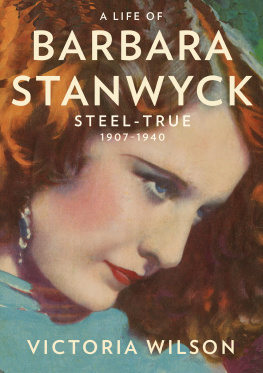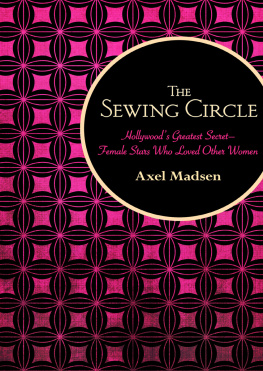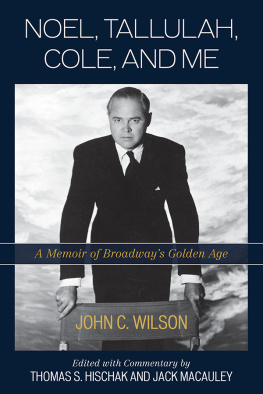Victoria Wilson - A Life of Barbara Stanwyck
Here you can read online Victoria Wilson - A Life of Barbara Stanwyck full text of the book (entire story) in english for free. Download pdf and epub, get meaning, cover and reviews about this ebook. publisher: Simon & Schuster, genre: Non-fiction. Description of the work, (preface) as well as reviews are available. Best literature library LitArk.com created for fans of good reading and offers a wide selection of genres:
Romance novel
Science fiction
Adventure
Detective
Science
History
Home and family
Prose
Art
Politics
Computer
Non-fiction
Religion
Business
Children
Humor
Choose a favorite category and find really read worthwhile books. Enjoy immersion in the world of imagination, feel the emotions of the characters or learn something new for yourself, make an fascinating discovery.
- Book:A Life of Barbara Stanwyck
- Author:
- Publisher:Simon & Schuster
- Genre:
- Rating:3 / 5
- Favourites:Add to favourites
- Your mark:
A Life of Barbara Stanwyck: summary, description and annotation
We offer to read an annotation, description, summary or preface (depends on what the author of the book "A Life of Barbara Stanwyck" wrote himself). If you haven't found the necessary information about the book — write in the comments, we will try to find it.
Michael Korda on A Life of Barbara Stanwyck: Steel-True 1907-1940 By Victoria Wilson
Michael Korda has been Victoria Wilsons editor during the fifteen years of the Stanwyck project. He was the Editor in Chief of Simon and Schuster for 37 years and edited the likes of Richard Nixon, Ronald Reagan, David McCullough, and countless others. He is also the prolific author of Hero: The Life and Legend of Lawrence of Arabia, Ulysses S. Grant, With Wings Like Eagles, and more. He lives in upstate New York.
The phrases long awaited and groundbreaking are often cast around rather too loosely in book publishing, but for once they apply with perfect truth to Victoria Wilsons A Life of Barbara Stanwyck: Steel True, 1907-1940, the first volume of her remarkable biography of the brilliant, enigmatic and complex actress whose life spanned the richest and fastest changing period of the motion picture business, which included the coming of sound and the beginning of color, and whose career took her from Broadway to Hollywood stardom and television.
Movie star biographies taken as a genre tend to be slim and short on facts, more about glamor (and occasionally scandal) than about the business of becoming a star, but Victoria Wilson has brought to her subject the narrative brilliance, the phenomenal research, and the broad historical overview of such distinguished biographers as Robert Caro and David McCulloughindeed this may be, to my knowledge is, the first time that a figure from the world of show business has been treated as a serious subject, and the result is a major book that is not only endlessly fascinating, but full of surprises, and above all thoroughly readable from the first page to the last.
Ms. Wilson has that most important of qualities for a biographer, empathy for her subject, but also the thirst for details, the determination to root Barbara Stanwyck firmly in her time, and a real sense not only for what made Barbara Stanwyck tick, but for how a movie gets made, as well as for the perfectionism and determination that made Stanwyck a legendary performer who worked with such demanding directors as Frank Capra, King Vidor, Cecil B. DeMille, Preston Sturges, Billy Wilder, Fritz Lang, and Anatole Litvak.
In the process, Ms. Wilson presents not just a riveting and profoundly convincing portrait of Barbara Stanwyck, both as a woman and as a hugely gifted performer, with a careful, subtle description of her strengths and her weaknesses, but a sweeping panorama of the world she came from, grew up in, and from which she fought her way up to stardom at a time when America itself was changing radically and going through great historical crises.
Fifteen years in the makingand that despite a career that has taken Victoria Wilson to an enviable position as one of the most respected editors in book publishing, Vice President and Senior Editor at Alfred A. KnopfA Life of Barbara Stanwyck: Steel True 1907-1940 establishes her as a uniquely gifted biographer, as sensitive to Barbara Stanwycks traumatic childhood, complicated emotional life and difficult marriage as she is to understand that most complicated of all the creative arts, the making of a motion picture. In a career that spanned eighty-eight motion pictures, including such classics as Stella Dallas, Union Pacific, Double Indemnity, and Sorry, Wrong Number, Barbara Stanwyck carved out for herself a unique place as a great star who brought to the screen much of the fierce intelligence, complexity, artistic integrity and inner resolve that marked her own life.
This first volume ends with Stanwyck at the peak of her career, and I believe it will make you, as it did me, look forward expectantly to the next volume.
Victoria Wilson: author's other books
Who wrote A Life of Barbara Stanwyck? Find out the surname, the name of the author of the book and a list of all author's works by series.









